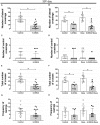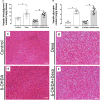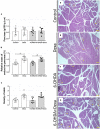Glucose Homeostasis Is Not Affected in a Murine Model of Parkinson's Disease Induced by 6-OHDA
- PMID: 30686986
- PMCID: PMC6333712
- DOI: 10.3389/fnins.2018.01020
Glucose Homeostasis Is Not Affected in a Murine Model of Parkinson's Disease Induced by 6-OHDA
Abstract
There is a mutual relationship between metabolic and neurodegenerative diseases. However, the causal relationship in this crosstalk is unclear and whether Parkinson's disease (PD) causes a posterior impact on metabolism remains unknown. Considering that, this study aimed to evaluate the appearance of possible changes in metabolic homeostasis due to 6-hydroxydopamine (6-OHDA) administration, a neurotoxin that damage dopaminergic neurons leading to motor impairments that resemble the ones observed in PD. For this, male Wistar rats received bilateral 6-OHDA administration in the dorsolateral striatum, and the motor and metabolic outcomes were assessed at 7, 21, or 35 days post-surgical procedure. Dexamethasone, a diabetogenic glucocorticoid (GC), was intraperitoneally administered in the last 6 days to challenge the metabolism and reveal possible metabolic vulnerabilities caused by 6-OHDA. Controls received only vehicles. The 6-OHDA-treated rats displayed a significant decrease in locomotor activity, exploratory behavior, and motor coordination 7 and 35 days after neurotoxin administration. These motor impairments paralleled with no significant alteration in body mass, food intake, glucose tolerance, insulin sensitivity, and biochemical parameters (plasma insulin, triacylglycerol, and total cholesterol levels) until the end of the experimental protocol on days 35-38 post-6-OHDA administration. Moreover, hepatic glycogen and fat content, as well as the endocrine pancreas mass, were not altered in rats treated with 6-OHDA at the day of euthanasia (38th day after neurotoxin administration). None of the diabetogenic effects caused by dexamethasone were exacerbated in rats previously treated with 6-OHDA. Thus, we conclude that bilateral 6-OHDA administration in the striatum causes motor deficits in rats with no impact on glucose and lipid homeostasis and does not exacerbate the adverse effects caused by excess GC. These observations indicate that neurodegeneration of dopaminergic circuits in the 6-OHDA rats does not affect the metabolic outcomes.
Keywords: Parkinson’s disease; glucocorticoid; glycemia; lipids; liver; pancreatic islets.
Figures











Similar articles
-
Glucose homeostasis in rats treated with 4-vinylcyclohexene diepoxide is not worsened by dexamethasone treatment.J Steroid Biochem Mol Biol. 2017 Jan;165(Pt B):170-181. doi: 10.1016/j.jsbmb.2016.06.001. Epub 2016 Jun 3. J Steroid Biochem Mol Biol. 2017. PMID: 27264932
-
Mechanism of the beneficial effect of melatonin in experimental Parkinson's disease.Neurochem Int. 2014 Dec;79:1-11. doi: 10.1016/j.neuint.2014.09.005. Epub 2014 Sep 28. Neurochem Int. 2014. PMID: 25263280
-
Intranasal insulin protects against substantia nigra dopaminergic neuronal loss and alleviates motor deficits induced by 6-OHDA in rats.Neuroscience. 2016 Mar 24;318:157-65. doi: 10.1016/j.neuroscience.2016.01.020. Epub 2016 Jan 14. Neuroscience. 2016. PMID: 26777890 Free PMC article.
-
Decreased synaptic plasticity in the medial prefrontal cortex underlies short-term memory deficits in 6-OHDA-lesioned rats.Behav Brain Res. 2016 Mar 15;301:43-54. doi: 10.1016/j.bbr.2015.12.011. Epub 2015 Dec 18. Behav Brain Res. 2016. PMID: 26707254
-
Impact of glucocorticoid treatment before pregnancy on glucose homeostasis of offspring exposed to glucocorticoid in adult life.Life Sci. 2019 Nov 15;237:116913. doi: 10.1016/j.lfs.2019.116913. Epub 2019 Oct 14. Life Sci. 2019. PMID: 31622609
Cited by
-
Behavioral Tests in Neurotoxin-Induced Animal Models of Parkinson's Disease.Antioxidants (Basel). 2020 Oct 16;9(10):1007. doi: 10.3390/antiox9101007. Antioxidants (Basel). 2020. PMID: 33081318 Free PMC article. Review.
-
Changes in Liver Lipidomic Profile in G2019S-LRRK2 Mouse Model of Parkinson's Disease.Cells. 2023 Mar 4;12(5):806. doi: 10.3390/cells12050806. Cells. 2023. PMID: 36899942 Free PMC article.
-
Parkinson's Disease and the Heart: Studying Cardiac Metabolism in the 6-Hydroxydopamine Model.Int J Mol Sci. 2023 Jul 30;24(15):12202. doi: 10.3390/ijms241512202. Int J Mol Sci. 2023. PMID: 37569578 Free PMC article.
References
LinkOut - more resources
Full Text Sources
Miscellaneous

